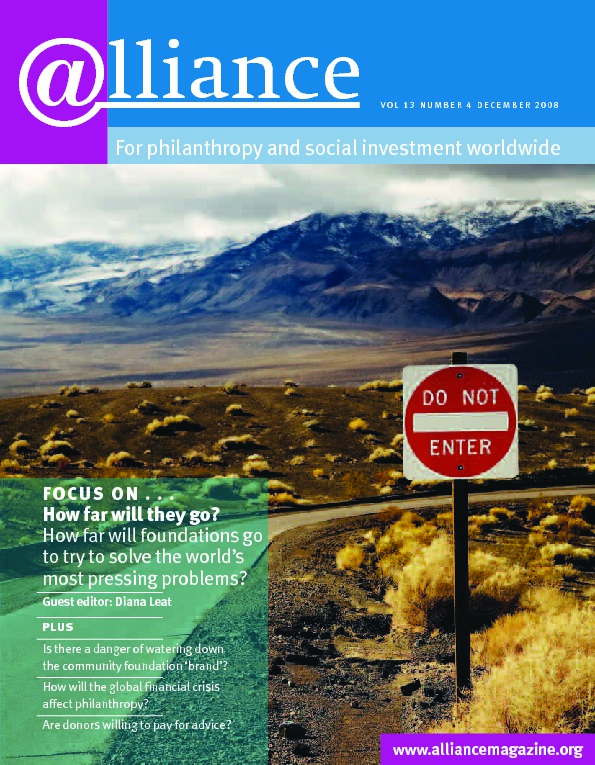 Everyone loves to moan about a crisis, in this case an economic one. The words meltdown and tsunami are frequently used to describe the current situation. We are prone to take the most dire situation facing an NGO we are familiar with and extrapolate from the particular to the general. So it comes with a bit of relief, if not a dash of disappointment, when the data doesn’t uphold the doom and gloom.
Everyone loves to moan about a crisis, in this case an economic one. The words meltdown and tsunami are frequently used to describe the current situation. We are prone to take the most dire situation facing an NGO we are familiar with and extrapolate from the particular to the general. So it comes with a bit of relief, if not a dash of disappointment, when the data doesn’t uphold the doom and gloom.
Giving USA has looked at the data over the past 40 years, a period of time that has included economic slowdowns, short recessions and long recessions (eight months or more in a given calendar year). When giving is segmented into the three categories of individual giving, foundation giving and corporate giving, it is hard, in the aggregate, to see what all the fuss is about. Total giving, adjusted for inflation, averaged 2.8 per cent annual growth across the 40-year period (1967-2007). In slowdown years that average dropped to 0.8 per cent, but it was still growth. During short recessions, the average was a decline of 1 per cent and during longer recessions, it was 2.7 per cent. And the figures were not significantly different for foundations nor, surprisingly, for corporations.
Now, if you want to argue that this economic downturn is structurally different from those of the past, something we are inclined to do, but which with the benefit of hindsight usually turns out to be wrong, then all bets are off. It is not something I am inclined to do, at least not yet. In addition, my general propensity to see the glass half full rather than half empty and leaking leads me to make the assumption that the basic trends we see for the US hold for the situation outside the US.
As always with aggregate data, the devil is in the detail, so here are a few issues to watch that require disaggregation and more study. First, will the economic downturn have a different effect on specific substantive subsectors like health, education, arts and religion and on edgier issues like human rights, community organizing and climate control? The second issue stems from the fact that organized philanthropy encompasses a much greater diversity of giving models and styles than ever before. What will be the effect of the economic downturn on internet giving, venture philanthropy, remittances from diaspora communities, and those who have put sunset provisions on their organization’s life or are part of the ‘give while you live’ movement.
Third, what will be the consequence of the growing number of global corporate mergers and acquisitions on their giving programmes. Will it mean fewer staff giving away less money, or is the increasing cachet of global corporate responsibility strong enough to buck this trend? Finally, who are the NGOs that come into vogue in bad times? Is it the ones that are countercyclical? Foundations are wired to think of substance rather than function, but does function come into its own in troubled times? And here I’m thinking of many NGO support organizations that work on fundraising, strategic communications and governance.
NGOs for the most part operate on small margins where unrestricted funds are meagre and working reserves almost unheard of. So even a small decline in giving can mean becoming unsustainable. After all, a colleague of mine once quipped that we have a non-profit sector because no one has figured out how to make money out of what we do. Given this reality, I would suggest five principles to help guide non-profit leaders.
First, don’t panic, and be particularly attentive to the anxiety of your staff. Second, put yourself through a contingency planning exercise with a series of best and worst case scenarios. Third, think strategically about what you do and how you do it and make necessary adjustments. Fourth, engage in a bit of ‘high touch’ with your most important supporters and partners. Finally, this is the time to be vigilant about your mission. When facing a belt tightening, funders are more likely to be focused on how you perform that mission.
Even at the bleakest of times, there are opportunities for those that can fight off the tendency to become immobilized or chase funding for activities regardless of how it aligns with mission. It may be unpopular to say so, but a periodic shake-out is not all bad. It helps reduce duplication and unsustainable efforts. On the positive side, it presents new possibilities for strategic alliances that play to the strength of all. In a peculiar way, the changing priorities of organized philanthropy may be more of a threat than a downturn in the economy. Especially if the changes are precipitous and not handled responsibly and with sensitivity.
Barry D Gaberman can be contacted at bgaberman@gmail.com



Comments (0)